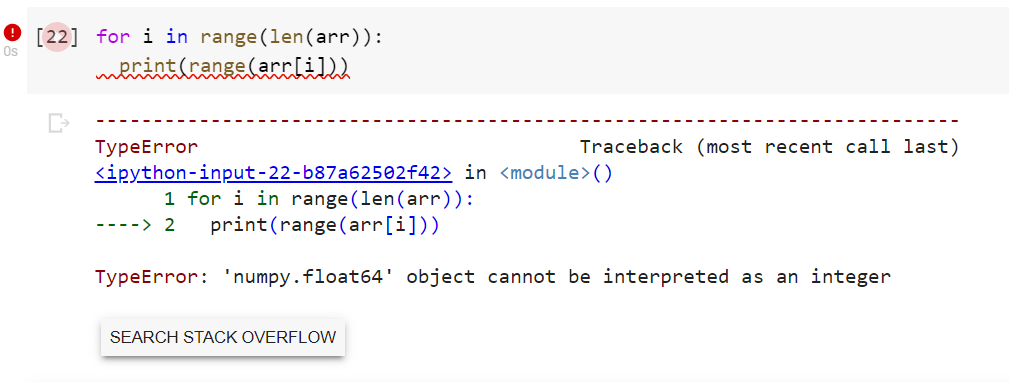‘Numpy.Float64’ Object Is Not Callable
Introduction: What is a “numpy.float64” Object?
In Python, NumPy is a widely used library for numerical computations. NumPy provides efficient and convenient data structures, such as arrays, and a wide range of mathematical functions to manipulate these arrays. One of the commonly used data types in NumPy is “numpy.float64,” which represents a 64-bit floating point number.
However, sometimes when working with NumPy and utilizing “numpy.float64” objects, you may encounter an error message stating “‘numpy.float64’ object is not callable.” This error can be frustrating, especially for beginners, but it is important to understand its causes and explore possible solutions to resolve it.
Reasons for the Error: “‘numpy.float64’ object is not callable”
The error “‘numpy.float64’ object is not callable” typically occurs when you are trying to call a method or function on a “numpy.float64” object that cannot be invoked. Here are some common reasons behind this error:
1. Syntax Errors: One possible reason for the error is a syntax mistake in your code. This could be a missing or misplaced parenthesis, incorrect indentation, or a typo when referencing the “numpy.float64” object.
2. Accidental Reassignment: Another common cause is accidentally reassigning a variable that was originally a “numpy.float64” object to a different data type or value. This can happen if you inadvertently overwrite the original object with a new value or assignment.
3. Incorrect Verification of Object Type: It is essential to confirm that the variable you are working with is indeed a “numpy.float64” object. If it is not, trying to call methods or functions specific to “numpy.float64” objects may result in the error message.
4. Importing and Using the Correct NumPy Function: The error might occur if you mistakenly import or use the wrong NumPy function. Ensure that you are using the appropriate functions compatible with “numpy.float64” objects.
5. Incorrect NumPy Version: Incompatibility between the version of NumPy installed and the functions you are trying to use can lead to the “‘numpy.float64’ object is not callable” error. Checking and updating the NumPy version might resolve this issue.
6. Conflicts with Other Libraries or Modules: If you are using other libraries or modules alongside NumPy, some functions or methods might conflict, resulting in the error. Identifying and resolving any conflicts can help address the issue.
7. Compatibility Issues with Specific NumPy Version: Certain code or functions may not be compatible with specific versions of NumPy due to updates or changes in functionality. Ensuring compatibility with the specific version you are using can help avoid the error.
8. Seeking Help and Consultation: If none of the above solutions work, it is advisable to seek help from the supportive NumPy community or consult the official documentation for further assistance in resolving the “‘numpy.float64’ object is not callable” error.
Possible Solutions for the Error: “‘numpy.float64’ object is not callable”
1. Check for Syntax Errors:
– Review your code for any syntax mistakes, such as missing parentheses, incorrect indentation, or typographical errors.
2. Check for Accidental Reassignment:
– Verify that you have not accidentally reassigned the variable to a different data type or value. Double-check your assignments and ensure they are compatible with “numpy.float64” objects.
3. Verify if the Variable is Indeed a “numpy.float64” Object:
– Use the `type()` function to verify the data type of the variable containing the “numpy.float64” object. If it is not a “numpy.float64” object, investigate and correct any inconsistencies.
4. Import and Use the Correct NumPy Function:
– Make sure you are importing the necessary NumPy function that is compatible with “numpy.float64” objects. Review the official documentation to find the appropriate function for your needs.
5. Ensure the Correct Version of NumPy is Installed:
– Check the installed version of NumPy and ensure it is up-to-date. Updating NumPy to the latest version can help address any compatibility issues.
6. Check for Conflicts with Other Libraries or Modules:
– Examine your code for any conflicts between NumPy and other libraries or modules you are using. Resolve conflicts by using alternate functions or modifying your code as necessary.
7. Verify the Compatibility of the Code with the Specific Version of NumPy:
– If you suspect compatibility issues with a specific version of NumPy, cross-reference your code with the documentation for that version. Make any required modifications to align with the functionalities and syntax of that version.
8. Seek Help from the NumPy Community or Consult the Official Documentation:
– If you have exhausted all other solutions, reach out to the helpful NumPy community for assistance. Posting your issue on relevant forums or seeking guidance from experienced users can provide valuable insights. Additionally, consulting the official NumPy documentation can often offer detailed explanations and solutions for various errors.
Frequently Asked Questions (FAQs):
Q1. What is the “Numpy.float64” object?
A1. The “Numpy.float64” object is a NumPy data type that represents a 64-bit floating-point number. It is commonly used for numerical computations involving decimal numbers with a high level of precision.
Q2. What are some other related errors when working with “numpy.float64” objects?
A2. Apart from the “‘numpy.float64′ object is not callable” error, you may encounter errors like “Numpy float64 object is not iterable,” “Numpy float64 object cannot be interpreted as an integer,” “Numpy ndarray object is not callable,” “Float’ object is not callable,” “Int’ object is not callable,” and “Cannot unpack non-iterable numpy float64 object.”
In conclusion, encountering the “‘numpy.float64’ object is not callable” error can be challenging, but understanding its causes and following the suggested solutions can help resolve the issue. Remember to review your code for syntax errors, verify the object type, check for compatibility, and seek help if needed. By addressing these potential pitfalls, you can overcome the error and continue working efficiently with NumPy and its “numpy.float64” objects.
Typeerror: ‘Numpy.Float64’ Object Cannot Be Interpreted As An Integer / Tensorflow Object Detection
What Is Float64 In Numpy?
NumPy, which stands for Numerical Python, is a powerful library in Python used for scientific computing. It provides efficient and convenient numerical arrays, along with a large collection of mathematical functions, operations, and tools. One important data type in NumPy is float64.
Float64 is a floating-point data type that represents real numbers with double precision. The “64” in float64 indicates that it uses 64 bits to store the value. This data type can accurately represent a very wide range of decimal numbers with high precision, making it suitable for various scientific and numerical applications.
In NumPy, float64 can be used to create arrays or matrices that store floating-point values. It is particularly useful when dealing with large datasets that require high precision arithmetic, such as numerical simulations, mathematical modeling, statistical analysis, and more.
To create a float64 array in NumPy, you can use the `dtype` argument when initializing an array. For example:
“`python
import numpy as np
arr = np.array([1.2, 3.4, 5.6], dtype=np.float64)
“`
In the above code, we create a NumPy array `arr` containing the values `[1.2, 3.4, 5.6]` with a float64 data type. The use of float64 ensures high precision and allows for accurate computations on the array.
Using float64 arrays in NumPy provides several advantages. Firstly, it allows for efficient storage and manipulation of large numerical datasets. Since float64 uses 64 bits, it can represent numbers with precision up to 15 decimal places. This is particularly important when dealing with scientific calculations and simulations that require a high level of accuracy.
Secondly, float64 arrays facilitate vectorized operations, which significantly enhance the performance and speed of numerical computations. NumPy provides a wide range of mathematical functions and operations that can be directly applied to float64 arrays, making it easy to perform complex calculations on large datasets efficiently.
Furthermore, float64 arrays allow seamless integration with other scientific libraries in Python, such as SciPy, Matplotlib, and Pandas. These libraries leverage NumPy’s float64 arrays, enabling scientists, researchers, and data analysts to perform data manipulation, analysis, visualization, and modeling with ease.
FAQs about float64 in NumPy:
Q: What is the difference between float64 and float32 in NumPy?
A: The main difference lies in the precision and storage requirements. Float64 uses 64 bits, providing higher precision up to 15 decimal places compared to float32, which uses 32 bits and offers precision up to 7 decimal places. Additionally, float64 requires more memory compared to float32.
Q: Can float64 arrays handle large datasets?
A: Yes, float64 arrays are suitable for handling large datasets efficiently. With 64 bits, they can store and manipulate a vast amount of numerical data with high precision.
Q: Are there any limitations or potential issues with float64 arrays?
A: One important consideration is memory usage. Since float64 arrays have larger storage requirements compared to other data types, they can consume more memory. Therefore, it is essential to consider memory constraints, especially when working with very large datasets.
Q: Are there any alternatives to float64 in NumPy?
A: Yes, NumPy provides several other data types for floating-point values, including float16 and float32. These data types consume less memory compared to float64 but have lower precision. The choice of data type depends on the specific requirements of the application.
Q: How can I convert a float64 array to a different data type in NumPy?
A: NumPy provides functions to convert the data type of an array, such as `astype()`. You can use it as follows:
“`python
arr = np.array([1.2, 3.4, 5.6], dtype=np.float64)
arr = arr.astype(np.float32)
“`
In the above code, `astype(np.float32)` converts the `arr` array from float64 to float32 data type.
In conclusion, float64 is a crucial data type in NumPy that provides high precision and efficient storage for working with floating-point numbers. Its ability to handle large datasets and facilitate efficient numerical computations makes it an essential component for scientific computing and data analysis in Python.
Why Is Numpy Float 64 Not Iterable?
When working with numerical data in Python, the numpy library is a powerful tool for array manipulation and computation. It provides an extensive range of functions and capabilities for numerical operations. However, working with numpy arrays may sometimes lead to confusion, especially when dealing with data types such as float64 that are not iterable. In this article, we will explore the reasons behind this behavior and provide a comprehensive understanding of the topic.
Understanding Numpy Data Types
Before delving into the intricacies of why numpy float64 is not iterable, we must first grasp the concept of numpy data types. Numpy arrays are homogeneous, meaning that all elements in a single array must have the same data type. These data types, or dtypes, can range from basic numerical types like integers and floats to complex numbers, strings, booleans, and many others.
Numpy uses data types to efficiently store and manipulate arrays. Each data type has a fixed size in memory, allowing numpy to optimize memory usage and enhance performance. The float64 dtype, also known as double precision float, is one of the available options and is commonly used for high-precision decimal calculations.
Iterating over Numpy Arrays
In Python, arrays and other iterable objects can be accessed through iteration with loops or using built-in functions like “enumerate()” or “zip()”. However, numpy arrays behave differently and cannot be directly iterated over using these methods. Attempting to directly iterate over a numpy array, irrespective of its data type, will result in a TypeError, stating that the array is not iterable.
The main reason behind this behavior lies in the design philosophy and performance optimizations of numpy. Numpy arrays are typically large, and allowing direct iteration would be inefficient in terms of memory and performance. Instead, numpy provides vectorized operations, which allow for applying operations on arrays as a whole without the need for explicit iteration.
Vectorized Operations in Numpy
Under the hood, numpy uses highly optimized C or Fortran functions to execute vectorized operations efficiently. These operations are designed to work on entire arrays or subsets of arrays at once, leveraging the capabilities of modern CPUs and GPUs. As a result, vectorized operations are significantly faster than traditional loop-based iterations, making numpy a go-to library for numerical calculations.
Instead of directly iterating over a numpy array, it is advised to utilize the rich set of vectorized operations that numpy provides. These include mathematical functions like addition, subtraction, multiplication, division, exponentiation, and trigonometric functions, among others. Additionally, numpy offers numerous statistical and logical functions, as well as indexing and slicing capabilities, to manipulate array data effectively.
FAQs
Q: Can I convert a numpy array to an iterable data structure?
A: While numpy arrays cannot be directly iterated over, they can be easily converted to other iterable data structures, such as Python lists, using the “tolist()” function. This allows for more conventional iteration using Python’s built-in methods.
Q: Are there any alternatives for iterating over numpy arrays?
A: In some cases, when it is absolutely necessary to iterate over a numpy array, the “nditer()” function can be used to generate an iterator object that allows access to individual elements. However, this should be used sparingly, as it may undermine the performance benefits that numpy offers.
Q: Can I change the data type of a numpy array to make it iterable?
A: Unfortunately, changing the data type of a numpy array does not affect its iterability. Numpy arrays, regardless of their data type, are designed for vectorized operations and not direct iteration.
Q: I need to perform element-wise operations on an array. How can I achieve this without direct iteration?
A: Numpy provides a set of functions called “ufuncs” (universal functions) that are specifically designed for element-wise operations. These functions, such as “numpy.add()”, “numpy.subtract()”, and “numpy.multiply()”, allow for efficient operation execution on entire arrays, eliminating the need for explicit iterations.
In conclusion, numpy float64 and other numpy data types are not iterable due to the performance optimizations and design philosophy of the library. Instead of resorting to direct iteration, it is recommended to utilize numpy’s vectorized operations and functions for efficient array manipulation and computation.
Keywords searched by users: ‘numpy.float64′ object is not callable Numpy float64 object is not callable auc, Numpy float64 object is not iterable, Numpy float64 object is not callable f1_score, Numpy ndarray object is not callable, Float’ object is not callable, Numpy float64 object cannot be interpreted as an integer, Int’ object is not callable, Cannot unpack non iterable numpy float64 object
Categories: Top 71 ‘Numpy.Float64’ Object Is Not Callable
See more here: nhanvietluanvan.com
Numpy Float64 Object Is Not Callable Auc
Numpy’s float64 object is a data type or a class that represents floating-point numbers with a precision of 64 bits. It offers a greater level of accuracy compared to the standard float data type in Python. This higher precision can be advantageous when dealing with complex numerical calculations where accuracy is crucial.
However, it is important to note that the float64 object is not directly meant to be used for area under the curve calculations or any specific statistical analysis. The confusion arises from the fact that the term AUC is often used in machine learning tasks where numpy arrays are commonly used, and people assume that Numpy might have a built-in method or function to calculate the AUC.
In reality, calculating the AUC involves using appropriate libraries or functions specific to the task at hand, such as scikit-learn’s `roc_auc_score()` or various other statistical or machine learning packages. These libraries and functions provide the necessary algorithms and implementations to calculate the AUC accurately. Numpy, on the other hand, primarily focuses on array manipulations and mathematical operations rather than specialized statistical analysis.
To exemplify the point, let’s consider an example where we want to calculate the AUC in a binary classification task using scikit-learn. We would import the required libraries and functions, load our dataset, train our model, make predictions, and then use the `roc_auc_score()` function to calculate the AUC.
“`python
import numpy as np
from sklearn.metrics import roc_auc_score
# Load dataset, train model, make predictions
y_true = np.array([0, 1, 1, 0]) # Actual labels
y_pred = np.array([0.2, 0.6, 0.8, 0.3]) # Predicted probabilities
# Calculate AUC
auc_score = roc_auc_score(y_true, y_pred)
print(“AUC:”, auc_score)
“`
As seen in the above example, Numpy is used to create and manipulate the arrays that are then passed as arguments to the `roc_auc_score()` function from scikit-learn. Numpy plays a supporting role in providing efficient data structures and operations, but it is not directly involved in the AUC calculation itself.
FAQs:
Q: Can’t we use Numpy to calculate the AUC directly?
A: No, Numpy doesn’t have a built-in function or method to calculate the AUC. It primarily focuses on array manipulations and mathematical operations, while AUC calculations involve specialized statistical analysis or machine learning libraries like scikit-learn.
Q: Why is there confusion regarding the float64 object and AUC calculation?
A: The confusion arises from the use of the term AUC in machine learning tasks, where Numpy is commonly used for array manipulations. People assume that since Numpy provides a higher precision float64 object, it might have a direct method or function to calculate the AUC. However, the AUC calculation requires specialized statistical analysis libraries.
Q: Are there any advantages to using the float64 object in Numpy?
A: Yes, the float64 object offers a higher precision compared to the standard float data type in Python. This increased precision can be beneficial in complex numerical computations where accuracy is critical.
In conclusion, the float64 object in Numpy provides a higher precision floating-point representation, but it is not directly involved in AUC calculations or specialized statistical analysis. Numpy primarily focuses on array manipulations and mathematical operations. To calculate the AUC, it is necessary to use appropriate libraries or functions specific to the task at hand, such as scikit-learn’s `roc_auc_score()`. Clarifying this misconception helps to ensure accurate data analysis and avoids unnecessary errors in machine learning or data science tasks.
Numpy Float64 Object Is Not Iterable
NumPy is a popular Python library that provides support for efficient numerical computations. It includes a versatile collection of functions and classes, making it invaluable for various scientific and mathematical operations. However, when working with NumPy, you might encounter an error message stating “float64 object is not iterable.” In this article, we will explore the meaning behind this error and understand potential causes and solutions. So let’s dive in!
Understanding Iteration in Python
Before delving into the specifics of the “float64 object is not iterable” error, let’s first grasp the concept of iteration in Python. Iteration is the process of repeatedly executing a block of code or accessing elements in a sequence, such as a list or an array. It allows us to perform operations on each element of the sequence individually without the need for repetitive code. Python provides a convenient way to implement iterations through loops, such as for loops and while loops.
Introduction to NumPy float64 Object
NumPy is primarily known for its ability to handle arrays, which can store elements of various data types. One of the most commonly used data types in NumPy arrays is float64. As the name suggests, float64 represents a 64-bit floating-point number. These numbers are used to represent decimal fractions and real numbers in scientific computations. Float64 is highly precise and allows for a wide range of values, making it suitable for many numerical calculations.
Understanding the Error: “float64 object is not iterable”
When attempting to iterate over a NumPy float64 object, you may encounter the error message “TypeError: float64 object is not iterable.” This error occurs because the float64 object is not designed to be iterable. In Python, iterating over an element or object means accessing its individual components one by one. However, a float64 object, being a single numerical value, does not have any components to iterate over. Therefore, this error is raised to indicate that the desired operation is not supported on the float64 object.
Common Causes of the “float64 object is not iterable” Error
1. Incorrect Usage of Iteration: The most common cause of this error is mistakenly attempting to iterate over a single float64 value. Remember, iterations are meant for sequences with multiple elements, and trying to iterate over a single value will trigger this error.
2. Unexpected Variable Type: Another possible cause is inadvertently assigning a float64 value to a variable that should have a different data type. This can happen if the variable was previously assigned an iterable object, and you later assign a float64 value to it.
3. Incorrect Indexing or Slicing: In some cases, the error may occur due to incorrect usage of indexing or slicing operations on the float64 object. These operations are meant for accessing specific elements of an iterable sequence, so applying them to a float64 object is not appropriate.
Solutions to the “float64 object is not iterable” Error
1. Verify Variable Types: Double-check the variable types in your code. Ensure that any variable used in an iteration is an iterable data type, such as a list or an array, rather than a float64 object. Make sure you assign float64 values to appropriate variables to avoid any data type conflicts.
2. Check Your Iterations: Review your code and verify that you are not accidentally attempting to iterate over a float64 object. If you need to perform a specific operation on a single float64 value, remember that there is no need for iteration.
3. Verify Indexing and Slicing Operations: If you are using indexing or slicing operations, confirm that they are not applied to a float64 object. These operations should only be used with sequences that can be indexed or sliced, such as arrays or lists.
FAQs:
Q1. Can I iterate over a NumPy float64 array?
No, you cannot directly iterate over a NumPy float64 array. Instead, you can iterate over the array’s elements by using a loop or other appropriate methods.
Q2. Are there alternative data types I can use to avoid the error?
Yes, if you need to iterate over your data, you can consider using NumPy arrays with data types that are iterable, such as int or float.
Q3. Can I convert a NumPy float64 object to an iterable data type?
Yes, you have the option to convert a float64 object to other iterable data types, such as lists. For example, you can use the tolist() method to convert a NumPy array to a Python list and then perform iterations on it.
Q4. Are there any specific situations where iterating over a float64 object might be necessary?
While iterating over a single float64 value may not be necessary in most cases, there could be situations where you have multiple float64 values stored in an array, and you need to iterate over that array to perform computations on each value individually.
In conclusion, the “float64 object is not iterable” error is a valuable cautionary message that prevents erroneous attempts to iterate over individual numerical values. It reminds us to review and validate our code, ensuring that iterations are only performed on the appropriate data types, such as arrays or lists. By understanding the nature of the error and applying the provided solutions, you can avoid this common stumbling block when working with NumPy’s float64 objects and enhance the efficiency of your numerical computations.
Images related to the topic ‘numpy.float64’ object is not callable

Found 45 images related to ‘numpy.float64’ object is not callable theme


























![Typeerror: 'list' Object is Not Callable [Solved] Typeerror: 'List' Object Is Not Callable [Solved]](https://linuxhint.com/wp-content/uploads/2021/10/Object-is-Not-Callable.jpg)
![Typeerror: 'list' Object is Not Callable [Solved] Typeerror: 'List' Object Is Not Callable [Solved]](https://linuxhint.com/wp-content/uploads/2021/10/word-image-129163-1.png)

![Accuracy_Score 中sklearn 指标的问题[关闭] | AI技术聚合 Accuracy_Score 中Sklearn 指标的问题[关闭] | Ai技术聚合](https://aitechtogether.com/wp-content/uploads/2022/03/GyMXw.webp)



![TypeError: 'int' object is not subscriptable [Solved Python Error] Typeerror: 'Int' Object Is Not Subscriptable [Solved Python Error]](https://www.freecodecamp.org/news/content/images/2022/10/in_not_subable.png)
![SOLVED] typeerror: numpy.float64 object is not callable Solved] Typeerror: Numpy.Float64 Object Is Not Callable](https://itsourcecode.com/wp-content/uploads/2021/01/IT-SOURCECODE_ICON-07.jpg)




![Typeerror: 'list' Object is Not Callable [Solved] Typeerror: 'List' Object Is Not Callable [Solved]](https://linuxhint.com/wp-content/uploads/2021/10/word-image-129163-2.png)





Article link: ‘numpy.float64’ object is not callable.
Learn more about the topic ‘numpy.float64’ object is not callable.
- How to Fix: TypeError: ‘numpy.float64’ object is not callable
- TypeError: ‘numpy.float64’ object is not callable – Stack Overflow
- How to Fix: TypeError: ‘numpy.float’ object is not callable?
- Difference between numpy.float and numpy.float64 – Stack Overflow
- How to solve TypeError: ‘numpy.float64’ object is not iterable
- What is np.float32 and np.float64 in numpy in simple terms? – Quora
- How To Convert a NumPy Array to List in Python – DigitalOcean
- [SOLVED] typeerror: numpy.float64 object is not callable
- ‘numpy.float64’ object is not callable – Kaggle
- TypeError: ‘numpy.float64’ object is not callable – DQ Courses
- TypeError: ‘float’ object is not callable in Python (Fixed)
- How to solve TypeError: ‘numpy.int64’ object is not callable
- ‘numpy.float64’ object is not callable – While Printing F1 Score
- Fix Float Object Is Not Callable in Python | Delft Stack
See more: https://nhanvietluanvan.com/luat-hoc/